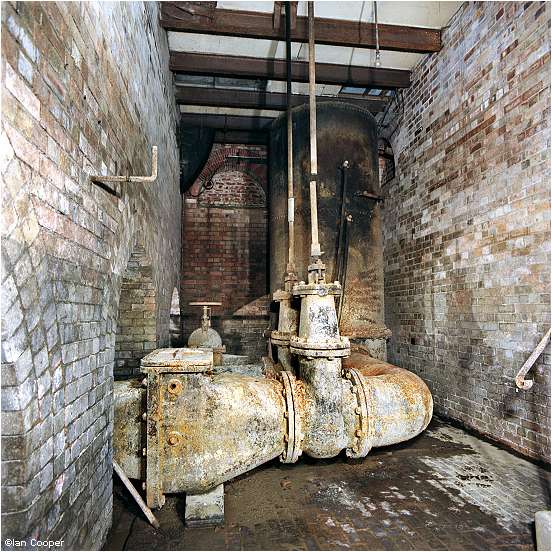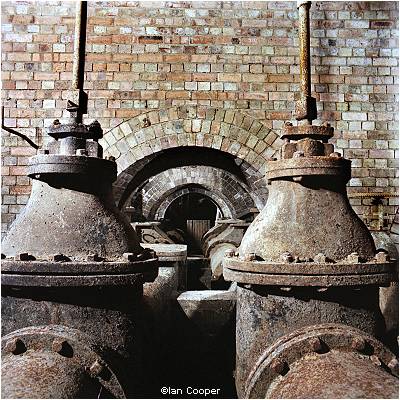Coleham Pumping Station |
||
Below The Surface The two beam engines and associated Cornish boilers at Coleham Pumping station represent only part of the pumping station machinery, albeit the most impressive and glamorous half. Hidden away under the flagstone floor is where the heart of the station lies; the four sewage pumps, their associated valves and pipe work, the steam engine condensers, feed pumps and boiler feed water tanks are located out of sight below ground level. Original access to this section of the pumping station was provided through a side door that led down a flight of steps to the machinery below. At some point the door was bricked up, leaving the only access via fixed ladders beneath access covers in the floor of the engine room. The two beam engines and associated Cornish boilers at Coleham Pumping station represent only part of the pumping station machinery, albeit the most impressive and glamorous half. Hidden away under the flagstone floor is where the heart of the station lies; the four sewage pumps, their associated valves and pipe work, the steam engine condensers, feed pumps and boiler feed water tanks are located out of sight below ground level. Original access to this section of the pumping station was provided through a side door that led down a flight of steps to the machinery below. At some point the door was bricked up, leaving the only access via fixed ladders beneath access covers in the floor of the engine room.The space beneath the engine house is split into four sections. The area nearest the boiler room contains the feed water tank and engine condensers, the middle two sections contain the boiler feed pumps and main sewage pumps, leaving the front area to house the pump isolation valves, air receiver and the original access door through the side of the building. The four sections are joined together by arched passageways that carry the pipe work the length of the building.
The sewer main crosses under the river Severn, adjacent to the pumping station, before entering the side of the engine house. Once inside the building the main splits in two, before splitting again to feed each of the main pumps, located either side of the engine's beam fulcrum. The discharge from the pumps runs along the centre of the building to the front section, where isolation gate vales are located, their control wheels being positioned in the engine room above. Beyond the isolation valves the pipes recombine before entering a large air receiver and the sewer main out of the pumping station.
 When the steam pumps were decommissioned their non-return valves were removed and the sewer main entering the building directed through three submersible electric pumps. The discharge from the electric pumps was passed back into the original pipe work before it exited the building, thus bypassing the steam pumps. In Autumn 2003 the submersible pumps were themselves decommissioned prior to a comprehensive renewal of the sewerage system in the vicinity of the pumping station. The new layout has seen all of the pumps, electrical control equipment and pipe work moved to a series of sumps and underground chambers outside the pumping station building, which has now been totally disconnected from the sewage network for the first time since the pumping station opened in 1901.
 Much of the equipment below floor level has now become redundant. The boiler feed pumps were disconnected whilst the pumping station was still operational, and after closure the pipes inside the two steam condensers were removed, rendering them useless until the pipes are replaced. To run the engines for demonstration purposes the exhaust from the engines has been re-routed to bypass the condensers straight to atmosphere outside the building. Early plans to reuse the original feed water tank were quickly abandoned when it was found to have badly corroded into holes. The tank's position just under the engine room floor makes access from below extremely difficult, and replacement would have required the lifting of the flagstone floor in the engine room. A small water tank at the back of the boiler room now provides feed water for the boiler. |
||
| All photographs are the work and copyright of Ian Cooper. | ||
